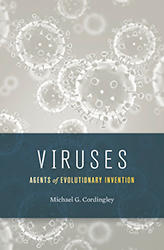Reviews
Issue: Microbial Tools
15 May 2018 article


Viruses: Agents of Evolutionary Invention
Written by M.G. Cordingley
Harvard University Press (2017)
£39.95 ISBN 978-0674972087
To many, viruses are merely agents of disease. However, over the years we have exploited them as reagents and tools for scientific investigation, as vaccines to protect against disease, and more recently, even for the treatment of human disease. Challenges such as viral outbreaks and epidemics, or antiviral drug resistance, demonstrate that viruses can change their characteristics, but the cells that viruses are dependent upon can change as well because of the infection. Viruses: Agents of Evolutionary Invention lays out the effects that viruses have on their hosts, whether single-celled like bacteria, or multicellular like plants and animals. The book covers how the changes that viruses have brought about over millions of years of evolution have contributed to the development of key processes like photosynthesis and the evolution of mammals.
Changes caused by viruses allow their hosts’ cells to behave differently under different environmental conditions, decreasing the survival potential of some and increasing the survival potential of others within a population. These environmental conditions act as selective pressures, thus driving the evolution of the viruses’ hosts and leading to the ‘invention’ of new forms of life, as suggested in the book title.
This book is a virology course in itself, describing the features that are important for replication, transmission and virulence in the context of the effects that viruses have upon their hosts. However, since Viruses describes the long-term effects on the evolution of species, as well as the short-term effects on individual hosts, the book will be of interest to not only virologists, but also those interested in evolution and biology in general. Despite being a wealth of information about viruses and their effects, it is a narrative, not a textbook. It is very well written, but it would benefit from a cheaper, more accessible paperback version.
Christopher Ring
Middlesex University
Fungi: Biology and Applications (3rd Edition)
Edited by K. Kavanagh
Wiley (2017)
£104 ISBN 978-1119374329
Fungi: Biology and Applications is in the third edition of this textbook, and maintains an excellent balance between the ease of reading of potentially complex and specific topics, while providing detail and subsequent sources of relevant information. The broad of range of subject matter compiled by the editor and the internationally recognised authors makes comprehensive reading. It covers the basics of fungal physiology, through genetics and genomics/proteomics, with reference to the post-genomics era, which is particularly significant given the avalanche of information that can be generated through next generation sequencing. The book continues by describing how fungi can be exploited by the human race, from the well-known use as a food source, to the potential production of pharmaceutical agents and chemical reagents, and the use of fungal derived enzymes in the ever-expanding biotechnology industry.
The deleterious side of fungi is not excluded. There are chapters on fungal plant and human pathogens, with significant detail on immunity and therapy included for the latter. The chapter on fungi in the environment provides an excellent understanding on how the actions of fungi are essential to all parts of the natural environment. One topic I feel could be covered in more detail is the impact of fungal disease on animals, as the number of species at threat of extinction through relatively novel fungal disease is of global concern, and is affecting many classifications of animal life.
Overall, the book provides excellent an addition to the library of those interested in the field of mycology, whether novice or expert, and the inclusion of the colour plates certainly adds a little zest.
P. Lewis White
UKCMN Regional Mycology Reference Laboratory, Public Health Wales Microbiology Cardiff


